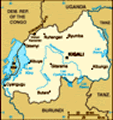Advertisement
Published: March 15th 2009
"This chapter is a bitter part of our lives, but one we must remember for those we lost and for the sake of the future." Quote from the Kigali Memorial Centre
Sadly, the main thing that most people associate with Rwanda is the 1994 genocide. Rwanda is a beautiful country with a sense of healing and worth a visit. Much of the countryside is cultivated, which is to be expected in a country with one of the highest population densities. Terraces climb hillsides, allowing crops to be grown on even the highest slopes. But, the genocide is part of the story of Rwanda.
I had decided not to visit the Kigali Memorial Centre before travelling around Rwanda, feeling that I wanted to see the country without a shadow. Instead, I went there on my return to Kigali (going from Burundi to Uganda). Sitting in bright sunshine, part way through my visit to the exhibition detailing the genocide, eased the darkness I felt only slightly. It gave me pause to reflect on my life and a problem I had, which suddenly seemed somewhat insignificant. It had been difficult to watch videos of survivors talking about the atrocities: they were
all young people who had lost loved ones. As one survivor said, "When someone tells you they have been unhappy for 10 years, they mean it."
Kigali is a compact and cosmopolitan city centre, with wide tree-lined avenues leading out to the suburbs. On my first day, I simply wandered around, soaking in the atmosphere and, after Kampala, marvelling at how ordered the traffic seemed; boda boda riders (motorcycle taxis) not only wear a helmet, they carry a spare that they insist passengers wear, drivers stop at pedestrian crossings! The only downside was that (unlike Uganda) boda boda drivers would not carry my rucksac in front of them and I didn't feel safe with it on my back - more walking then!
For my second night I moved to the Auberge du Caverne (a much better place than I stayed on the first night) where I met Barry, an American traveller, who suggested we visit two genocide memorials together.
We took a minibus to Nyamata and walked to the church where thousands of people had been murdered. Their clothes were piled on benches as a memorial and mass graves hold the remains of those killed. Charles, our
guide, was one of just 8 people who survived as a young boy. He said that he used to cry every time he told his story to tourists, but that it helped him to heal. He told us of the atrocities he had witnessed, how he saw his father killed and how he himself was saved by the absolute generosity and bravery of a man named Patrice.
From Nyamata, we took a minibus back towards Kigali to visit a second church at Ntarama, where 5000 people were killed. Again, our guide was survivor and showed us clothes of the victims hanging from the walls.
We had walked from the main road to get to Ntarama, having believed someone who said it was a short distance. However, enterprising bicycle taxis were waiting when we came out to take us back to the main road for a taxi to Kigali. It was a relief to be able to laugh as we sped down the hill with our riders racing each other.
Leaving Kigali the next day, having decided to travel together as we were heading the same way, Barry and I spent the night at the Faucon Hotel in
Butare. Butare is a small town but hosts the national museum - a very impressive display where there is also a rehabilitation programme teaching local crafts to young genocide survivors.
Travelling in Rwanda is very easy - smart, comfortable buses that depart on a schedule (rather than waiting until every seat is filled) and are not over-filled; excellent roads and made even better by travelling with Barry (who speaks French).
Having visited the market (not very spectacular) and the catholic cathedral (pretty impressive) we felt that we had seen everything Butare had to offer, so headed to Cyangugu, right on the border with the Congo. En route, we stopped off in Gikongoro. I had found the piles of clothing and the skulls at Nyamata and Ntarama distressing enough and decided to give Gikongoro memorial a miss as I didn't think I would be strong enough to view preserved bodies, so I waited with our bags while Barry went. From his descriptions, I was pleased I had not gone.
After a night at the Hotel des Chutes, we took bus back along the tea-plantation lined road we had arrived on to visit Nyungwe Forest National Park. The park

 Ntarama Genocide Memorial
Ntarama Genocide Memorial
Names of victims who have been identified.is beautiful rain forest with views over Burundi, and a huge troop of colobus monkeys - we didn't see any primates on our walk with Clever (our guide), but did see several beautiful bird species.
We knew that getting back to Cyangugu may be a challenge, but we didn't have to wait too long, sitting by the stone monkey at the park entrance to hitch a ride. Swerving round mountainous bends as speed is a guaranteed way for me to feel carsick (and no newspaper available to sit on).
We left the following day for the exciting ride back to Butare, then changing onto a bus heading to Burundi ... but that's a different story!
Advertisement
Tot: 0.226s; Tpl: 0.016s; cc: 20; qc: 79; dbt: 0.1522s; 1; m:domysql w:travelblog (10.17.0.13); sld: 2;
; mem: 1.3mb












